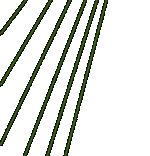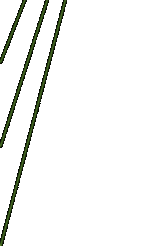Holographic
interferometry
Optical schemes of holographic interferometers
Classical
interferometres were made to solve the concrete problems and can not have the new
regulating. Unlike them, holographic interferometres are almost universal - same scheme
can be used for work with absolutely different objects. Nevertheless, some classification
exists here again.
At the large variety of
variants of the optical schemes of holographic interferometres (HI) for transparent
(phase) objects, all of them are divided in two types: with diffused and with collimated
working beam. Each scheme has the features and is applied depending on the problem.
HI with diffused object beam
If the object beam is
diffused (see fig.), this allows to observe interferometric pattern on the object by the
not armed eye on the bright background.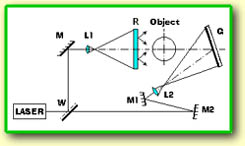 In this case within the limits of the aperture of
the hologram it is possible to allocate some directions for light transluence and to see
changes in interferomteric pattern. Thus each part of the hologram will have the
information about each point of object and the small slice of a plate will restore all
object wholly. In this case within the limits of the aperture of
the hologram it is possible to allocate some directions for light transluence and to see
changes in interferomteric pattern. Thus each part of the hologram will have the
information about each point of object and the small slice of a plate will restore all
object wholly.
Here W is beamsplitter,
M-M2 - mirrors, L1 and L2 - short focus lenses, R - transparent diffuser, G - hologram.
Such scheme is good
both for symmetric and non-symmetric objects, as allows at recording to distinguish
several directions under different angles. Because of using the diffuser in this case, the
restored image is covered by the speckle-noise. Parameters of the speckle-noise are caused
not only by properties of laser radiation, but also by characteristics of diffuser, and
adjustment is not possible. Using diffuser forces to direct to an object beam considerably
large part of energy of a laser radiation than in a reference beam.
Figures below show two
snapshots made from one hologram under different angles. HI was adjusted on an
indefinitely wide strip.
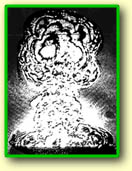 |
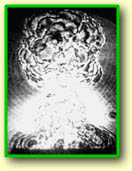 |
| a) |
b) |
HI with collimated object beam
The parallel object
beam (see fig. below) defines the precisely fixed direction of sounding. It is already
impossible to change this direction. In this case the image is observed by not armed eye
on a background of a bright light point. The normal image can be seen only through lens,
for example, photo camera.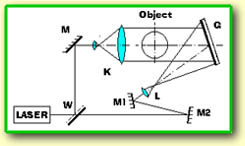 Here K is collimator. Here K is collimator.
The speckle-noise,
blurring interferometric strips, at such scheme of photo is much less, than at work with
diffused working beam. This way of recording is convenient for axial, flat or homogeneous
objects of radiation directions. It requires the energy in a object beam also less, than
previous sheme.-->
|

